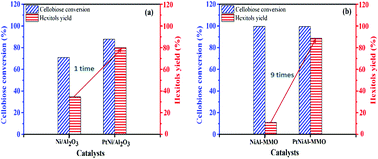Confined PtNi catalysts for enhanced catalytic performances in one-pot cellobiose conversion to hexitols: a combined experimental and DFT study†
Abstract
Ni nanoclusters were confined inside an alumina matrix through Ni–Al layered double hydroxide (NiAl-LDH) decomposition methods and studied in one-pot cellobiose conversion to hexitols. The TEM results indicated that very tiny Ni particles with a mean particle size of 0.95 nm were successfully incorporated in the Al2O3 matrix on the 5%NiAl-MMO catalysts. However, the performance was unexpectedly low with a 10% hexitol yield due to the strong interaction between Ni and Al, leading to the formation of NiAl2O4 and the low availability of Ni0 active species. Interestingly, a small amount of Pt dopant (0.5 wt%) dramatically improved the hexitol yield up to 88.8%, for an eight-fold improvement, on a 0.5%Pt5%NiAl-MMO catalyst. DFT simulations revealed that the Pt dopants showed greater reduction of the H2 activation barrier on small Ni clusters compared with that on larger Ni particles while at the same time increasing the Pt surface contents. The activated protons not only benefited the consequential hydrogenation step of glucose, but also contributed to the improved hydrolysis of celloboise. Compared with their counterparts of traditional impregnated alumina-supported PtNi catalysts, the confined PtNi-MMO catalyst showed a greater potential in biomass conversion in aqueous phase reactions.



 Please wait while we load your content...
Please wait while we load your content...